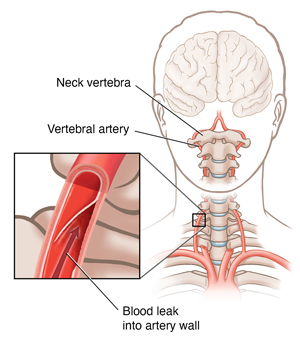Understanding Vertebral Artery Dissection (VAD)
The vertebral artery runs through the vertebra along each side of the neck. It supplies blood to the neck vertebrae (upper spinal cord) and the lower brain. The artery walls have several layers. If a tear occurs in the artery wall, blood leaks out between the layers. This is called dissection. This can lead to the formation of a blood clot resulting in stroke. Vertebral artery dissection is the most common cause of stroke in young and middle-aged adults, but it can occur at any age. It may also be called cervical artery dissection.

What causes vertebral artery dissection?
Anytime the physical makeup of the arterial wall is damaged, dissection can occur. This can occur after even a minor injury to the head or neck. This can happen during:
-
Physical activities such as wrestling, yoga, weight lifting and other sports, trampoline use, or riding a roller coaster
-
Childbirth
-
Sex
-
Coughing or sneezing
-
Infection or inflammation
-
Strangulation
-
Chiropractic manipulation (controversial)
-
Motor vehicle accident such as whiplash
Connective tissue disorders or vascular disorders may be linked with dissection, too. This is less common. Genes may also play a role.
Symptoms of vertebral artery dissection
Symptoms of vertebral artery dissection include symptoms of stroke or TIA (transient ischemic attack) and the following:
-
Headache
-
Neck pain
-
Tinnitus
-
Vertigo
-
Face pain and paralysis
-
Changes in vision
If you have symptoms of stroke or TIA, call 911.
When to call your healthcare provider
Call your healthcare provider right away if you have had a recent neck injury and have neck pain that isn't getting better or is getting worse.
Call 911
Call 911 if you have:
Symptoms of stroke or TIA. These include:
-
Weakness. You may feel a sudden weakness, tingling, or a loss of feeling on one side of your face or body, including your arm or leg.
-
Vision problems. You may have sudden double vision or trouble seeing in one or both eyes.
-
Speech problems. You may have sudden trouble talking, slurred speech, or problems understanding others.
-
Headache. You may have a sudden, severe headache.
-
Movement problems. You may have sudden trouble walking, dizziness, a feeling of spinning, a loss of balance, a feeling of falling, or blackouts.
-
Seizure. You may also have a seizure with a large or hemorrhagic stroke.
B.E. F.A.S.T. is an easy way to remember the signs of a stroke. When you see these signs, you need to call 911 fast.
B.E. F.A.S.T. stands for:
-
B is for balance. Sudden loss of balance or coordination or trouble walking.
-
E is for eyes. Vision changes in one or both eyes.
-
F is for face drooping. One side of the face is drooping or numb. When the person smiles, the smile is uneven.
-
A is for arm weakness. One arm is weak or numb. When the person lifts both arms at the same time, one arm may drift downward.
-
S is for speech difficulty. You may notice slurred speech or difficulty speaking. The person can't repeat a simple sentence correctly when asked.
-
T is for time to dial 911. If someone shows any of these symptoms, even if they go away, call 911 right away. Make note of the time the symptoms first appeared.